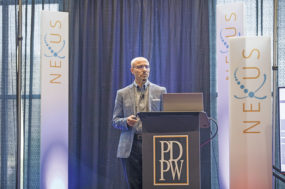Editor's note: While this article seeks to explain different options to protect milk prices and income margins, it's imperative you talk to professional milk marketers and insurance agents before making risk management decisions.
Part of the confusion in trying to develop a “safety net” for an individual dairy is the available tools use different factors to calculate costs and margins, so results aren’t always easily comparable. In addition, the “coverage” periods to apply those safety nets also differ.
Tools to try to protect income margins include two federal programs, the Margin Protection Program for Dairy (MPP-Dairy) and Livestock Gross Margin for Dairy (LGM-Dairy). Dairy co-ops may offer plans for members, and there’s the ability to purchase futures contracts for milk and feed, using puts and options to establish floors and ceilings in an effort to protect desired margins.
Alan Zepp, risk management program manager at Pennsylvania's Center for Dairy Excellence (CDE), reviews MPP-Dairy, LGM-Dairy and the Chicago Mercantile Exchange (CME) futures market during his monthly “Protecting Your Profits” conference calls.
With farmers eligible to drop out of MPP-Dairy for 2018, early indications are more producers are looking to LGM-Dairy to provide a safety net. According to USDA Risk Management Agency (RMA) data, the number of fiscal year 2018 policies sold have jumped dramatically, totaling nearly one-half of the number sold during all of fiscal year 2017. That may raise some federal funding concerns (more on that below).
Calculations differ
To help producers make decisions going forward, let’s first look at differences in income margin calculations under the two federally subsidized programs:
• Insurable LGM-Dairy margins are calculated with Class III milk futures prices and futures prices for corn and soybean meal. Producers can select the type of ration they want to include in the calculations. They can also select “deductible” levels of coverage.
• MPP-Dairy margins are calculated using monthly USDA National Ag Statistics Service national average prices for all milk, corn, soybeans and hay. MPP-Dairy has an established ration to calculate feed costs.
Those differences mean monthly milk income over feed cost margin calculations differ by about $1.50 per hundredweight (cwt), even though we’re talking about the same milk and a similar feed ration. For example, as of Dec. 1, the 10-month (February-November 2018) insurable margin under LGM-Dairy was about $7.02 per cwt. Full-year estimated 2018 margins projected under MPP-Dairy averaged $8.54 per cwt. While there’s a margin difference of about $1.52 per cwt between the two, the numbers essentially represent the same thing, Zepp said.
LGM-Dairy
LGM-Dairy users have greater flexibility, not only in selecting the time period covered, but also in selecting a ration to calculate the feed cost portion of the margin formula. LGM-Dairy allows producers to purchase income margin insurance on a monthly or multimonth basis (up to 10 months). The sales period is held the last Friday-Saturday of each month.
The December LGM-Dairy sales period is Dec. 29-30, with policies available through crop insurance agents certified to sell LGM-Dairy. Participants can purchase coverage for any month(s) between February-November 2018, or for the entire 10-month period.
LGM-Dairy is not without its risks. Coverage may be limited due to annual USDA Risk Management Agency budget caps. If the program reaches underwriting capacity during the year – as it did in 2011 – all policy sales cease until the next budget year. So far, the pace of sales in fiscal year 2018 is double the rate of 2017, but half the rate of 2011. If insurable margins improve, policy sales might too.
In addition to funding issues, computer problems have resulted in producers unable to purchase policies during designated sales periods. Under rules of the program, sales periods are not reopened in the event of technical problems.
MPP-Dairy
By now, most producers are familiar with MPP-Dairy, the program created in the 2014 Farm Bill. Participants could select the percentage of milk production they wanted to cover and the margin they wanted to insure in 50-cent increments, between $4 and $8 per cwt. The program's shortcomings have been well-documented. In part due to congressional tinkering, factors used in feed cost calculations did not represent true feed costs, resulting in artificially high income margins that seldom triggered indemnity payments. There hasn’t been an MPP-Dairy indemnity payment since May-June 2016, and then to only those insured at the top margin levels.
MPP-Dairy is in its final year in its current form, and proponents hope the program can be revised in the 2018 Farm Bill to provide a better safety net.
Cindy Walters, agricultural program specialist with Pennsylvania’s USDA Farm Service Agency (FSA), summarized MPP-Dairy as the 2018 enrollment deadline approaches.
• As in previous years, producers can sign up for catastrophic or buy-up coverage by Dec. 15.
• Producers can opt out of the 2018 program and simply do nothing, saving the $100 annual administrative fee.
• In the event milk prices or dairy margins decline dramatically, producers can late enroll for 2018 coverage anytime prior to Oct. 31, 2018, but only at the catastrophic ($4 per cwt) level. And, late filing does not provide protection retroactively. If a farmer files for 2018 MPP-Dairy in July 2018, he/she would not receive any payment for the January-February, March-April of May-June MPP-Dairy pay periods, even if the margin falls below $4 per cwt at any time during the first six months of the year.
A reminder: Producers who opt out of MPP-Dairy may purchase LGM-Dairy coverage, but they will no longer be eligible for MPP-Dairy coverage at any level. Participation in both MPP-Dairy and LGM-Dairy simultaneously remains forbidden.
Payout expectations
Depending on the level of coverage selected by an individual producer, LGM-Dairy provided indemnity payments over the past year, allowing producers to create their own safety net, Zepp said. However, market conditions have changed substantially.
For the foreseeable future, today’s expected LGM-Dairy insurable margins are the lowest since June 2014, proving less incentive for most producers to use the program except in setting a floor in event of a price crash.
“I don’t want to create any false enthusiasm. The standard stockbroker disclaimer applies: Past results don’t indicate future results,” Zepp said.
Those market changes have pulled MPP-Dairy back into the risk management picture for some producers, especially for those producing less than 4 million pounds of milk annually (Tier 1). Those producers receive a substantial break in premium costs compared to larger producers.
Based on milk and feed futures prices as of Dec. 4, the Program on Dairy Markets and Policy projected monthly MPP-Dairy margins to decline through May 2018, falling below $8 per cwt from February through June. Those margins would trigger MPP-Dairy indemnity payments for those insured at the top level.
“Everybody has been so angry with MPP-Dairy that they haven’t paid attention to it, but I honestly think it might fit, mostly for Tier 1 farms who just want some simple, basic coverage,” Zepp said. Purchasing $6.50 per cwt margin coverage for just 9 cents per cwt “might not be a bad decision.”
Comparing costs
As of Dec. 1, Class III futures prices averaged $15.32 per cwt; Class IV futures prices averaged $14.66 per cwt for the 12 months of 2018.
Using those milk prices and futures prices for corn and soybean meal in a minimum feed value ration, the 10-month insurable margin under LGM-Dairy would be about $7.02 per cwt.
Under LGM-Dairy’s least-cost calculations (common for producers who grow their own feed and may purchase some protein), protecting that margin would cost about 50 cents per cwt; a $1 deductible would cost 11 cents per cwt; and a $1.50 deductible policy would cost 5 cents per cwt.
Protecting an LGM-Dairy margin using a ration similar to MPP-Dairy would cost 54 cents per cwt for a zero-deductible policy; 14 cents per cwt for a $1 deductible policy; and 7 cents for a $1.50 deductible policy.
Under the same milk and feed price conditions, the estimated MPP-Dairy margin for all of 2018 was $8.54 per cwt. However, based on milk and feed futures prices as of Dec. 4, the Program on Dairy Markets and Policy projected monthly MPP-Dairy margins to decline from November 2017 through May 2018, falling below $8 per cwt from February through June. Those margins would trigger MPP-Dairy indemnity payments for those insured at the top level.
For Tier 1 producers buying $8 per cwt MPP-Dairy coverage, premiums cost 47.5 cents per cwt; $7 coverage cost 21.7 cents per cwt; and $6.50 per cwt coverage would cost 9 cents per cwt. If margins weaken further, those lower triggers could come into play.
Using options
For producers who choose the futures market to protect their milk price, individually or through their cooperative, a Class III put option to protect a March 2018 floor of $14.75 per cwt cost 60 cents per cwt; a $13.75 per cwt put option (similar to a $1 deductible LGM-Dairy policy) cost 20 cents per cwt. CME milk contracts typically cost 2-4 cents per cwt.
Put option costs fluctuate monthly, with costs to protect distant months higher due to the uncertainty of milk prices. For example, as of Dec. 1, a January 2018 “at-the-money” put on a Class III contract cost 30 cents per cwt, while a December 2018 put cost 94 cents per cwt.
CME contracts and options are sold on a monthly basis, and minimum volumes apply. CME contracts and options for Class III and Class IV milk are for 200,000 pounds of milk, covering the monthly milk production of 80 to 100 cows, depending on herd production levels. When marketing through a co-op, most – but not all – co-ops break futures contracts down to smaller increments. For example, a farm could sell 50,000 pounds of milk in one month instead of the 200,000-pound contract.
For producers purchasing feed, as of Dec. 1, using an “at the money” call option to set a $3.60 per bushel ceiling to buy corn in March would cost 9.2 cents per bushel. A 100-ton soybean meal contract for March 2018 was trading at $333.50 per ton. To establish a $335 per ton soybean meal price ceiling, an “at the money” call option was trading at $14.95 per ton.
Unpredictable market
There are a lot of questions looming for dairy markets in 2018, Zepp warned.
“2018 does not look like a strong year, at least for the first six months. I encourage producers to put some coverage on, at least for the beginning of the year. It could be LGM-Dairy or MPP-Dairy. If you’re looking for simple and easy, MPP-Dairy – with all its flaws – might be a best option for some.”
There may be other options ahead, but not likely in the near future. Best-guess scenarios suggest American Farm Bureau Federation’s Revenue Protection program might be implemented by September 2018.
Zepp's next Protecting Your Profits conference call is Dec. 20. The next sales period for LGM-Dairy is Dec. 29-30. ![]()

-
Dave Natzke
- Editor
- Progressive Dairyman
- Email Dave Natzke





